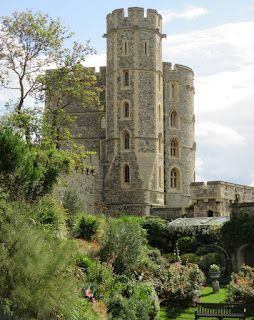After visiting the gardens and enjoying a champagne tea at Highgrove, our tour continued on to Thornbury Castle, a 500-year old property where King Henry VIII and Anne Boleyn once stayed. Today, it's a 26-room luxury hotel and restaurant in South Gloucestershire, England.
Doug waited for me in the hotel drawing room before we went for dinner.
This was the view (from the window in our master bathroom) of the walled garden; we stayed in the DeClare bedchamber on the top floor.
Thornbury Castle is behind St. Mary's Church, whose founding dates from the Norman period.
The next day we drove through the Cotswolds to the Oxfordshire village of Bampton, where most of the outdoor scenes for Downton Abbey were filmed. (Interiors were shot at Highclere Castle, near Newbury in Berkshire; the kitchen, servants' quarters and attic bedrooms were filmed at a set built at Ealing Studios, 60 miles away from Highclere Castle.)
The green outside of St. Mary's Church was where the fairground scene was filmed; Lady Mary was married in the chapel/Lady Edith was the disappointed bride.
Doug and I easily recognized Mrs. Crawley's house on the green, by the church.
Blenheim Palace - built between 1705 and 1722 in Woodstock, Oxfordshire, England - is the principal residence of the Dukes of Marlborough and birthplace (November 30, 1874) of Sir Winston Churchill.
Like the fictional Downton Abbey (Highclere Castle), Blenheim Palace was saved from ruin by funds gained from the 9th Duke of Marlborough's November 1896 marriage to American railroad heiress Consuelo Vanderbilt.
We entered Blenheim Palace - opened to the public for the first time in April 1950 - after crossing the Great Court.
Another similarity to Downton Abbey: Blenheim Palace was used as a convalescence hospital for wounded soldiers during WWI.
It was a lovely day so we also visited the Water Terraces, redesigned in the 1920s by Achille Duchene, a French landscape architect.
Before going inside Highclere Castle - the TV home of Downton Abbey - we walked around the grounds and gardens, designed by Britain's most famous landscape designer, Lancelot "Capability" Brown, who promoted natural overgrowth and rolling meadows.
Taking the path to the Monk's Garden, originally cultivated in the 12th century when the estate was occupied by the bishops of Winchester. The Carnarvon family acquired the estate in 1679.
Depending on the season, fruit trees and climbing roses mix with yew topiary in the Monk's Garden.
After leaving the Monk's Garden, we walked along the path in the Secret Garden, featuring borders planted with annuals, perennials and shrubs.
The area south of the castle is a meadow of wild flowers and natural grasses.
Our 2 weeks of touring museums, palaces, castles and gardens in England ended with a visit to Windsor Castle, the largest and oldest occupied castle in the world. (I took this photo around 5 p.m. on a week day - long after most tourists "called it a day.")
The weather was beautiful so we saw the 11 a.m. Changing of the Guard.
It's a challenge to see the castle's State Apartments, art from the Royal Collection, St. George's Hall, St. George's Chapel, Queen Mary's Dolls' House and gardens in a one-day visit.
Since Windsor Castle closes to the public at 5:15 p.m., downtown Windsor was not congested so the walk back to our hotel took only a few minutes - unlike in the morning when the castle opened to the public at 9:45 a.m.
(blog entries by Heidi Hutson)






























No comments:
Post a Comment